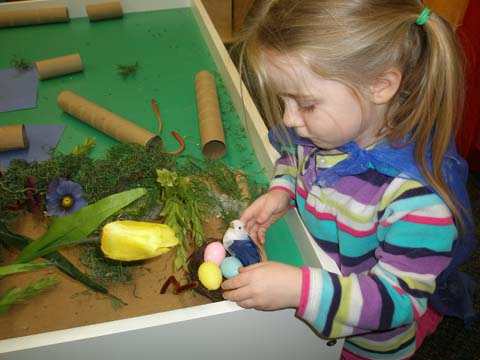I recently had the great pleasure of working with seven classroom teams of teachers who were trying hard to improve their implementation of the Project Approach. One question that came up repeatedly had to do with the notion of following the lead of the child. Several teachers were under the impression that the topic of a project can only result from an interest revealed by children during their play. I would like to share the explanation I gave these teachers in case others are also confused about this point.
Potential topics may indeed arise from a strong interest on the part of several children that is revealed in play. However, teachers can also intentionally propose project topics, or they may emerge from a thematic unit or another project that is currently under way. A teacher may propose a particular topic for a variety of reasons. For example, she may want to catch the interest of a particular child, as was the case in the project on cars featured in Rearview Mirror (2011). Or, the teacher may want to implement a project when other teachers in her school are focusing on a theme. In this case she may choose to propose a project that meets criteria for topic selection and relates to the theme. For example, if children in other classes are studying Valentine’s Day, the teacher who desires to engage her students in project work might propose a project on mail. On the other hand, a teacher who had started a thematic unit on Valentine’s Day might notice that many children in her class are interested in mail. In the former case, the project on mail emerged from the thematic unit.
No matter how a project begins, there is a point at which all teachers do follow the lead of the children in an authentic project. This point occurs toward the end of Phase 1 when the teacher judges whether there is sufficient interest among the children in the class to support an investigation. She may begin a discussion at circle time by saying something like, “Wow! We have spent a lot of time talking about mail this week. You have played mail carrier in the dramatic play area, dictated stories about mail, and drawn pictures about mail. Are there things you still want to find out about mail? Let’s list your questions here on this paper.” If the children do not show much curiosity about mail through their verbalizations or actions, then the teacher may decide to abandon the project on mail and attempt to identify a new topic that will be more engaging. This does not mean that every child in the class must have an intense curiosity about the topic, but project work requires shared interest among several children who are likely to participate in planning, investigation, and representation of findings.
Sharing these thoughts about following the lead of the child and its place in the project helped teachers new to project work understand that they may decide to intentionally provoke interest in a topic. They realized that there is a place for teacher-initiated work in project work and that they need to follow the lead of the child’s curiosity if an authentic project is to develop.

Sallee Beneke
Sallee (BenekeSalleeJ@sau.edu) is Professor and Director of Graduate Programs in ECE at St Ambrose University, Iowa. She coauthored The Project Approach for All Learners (2019) with Michaelene Ostrosky and Lilian Katz. Sallee used the Project Approach as a teacher and has worked to build the implementation of the approach via training and consulting. Sallee co-founded the IEL Project Approach Web site, and Facebook page with Lilian Katz, and she continues to contribute to the site.
Biography current as of 2021


